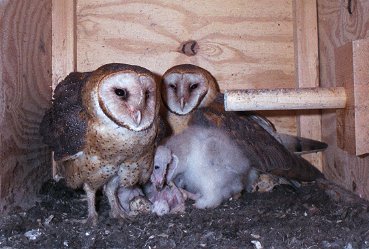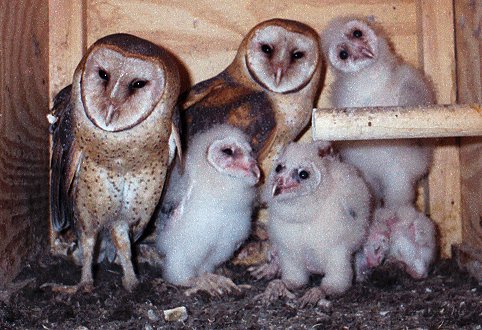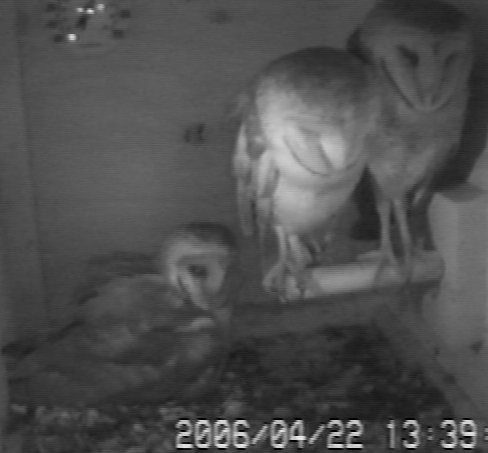Richard and Diane Van Vleck Personal Pages
The Home Habitat |
2006 Nestbox Video
Barn Owl Polygamy!
 After a two year absence, barn owls used the nest box in our barn again this year. When a second female joined the pair, this nesting became the focus of my 06 nest cam recording. While this wasn't a new species, it was the first I had heard of same nest polygamy in the barn owl. And, likely, this would be the first time anyone has observed such a rare nesting, thanks to the video camera.
After a two year absence, barn owls used the nest box in our barn again this year. When a second female joined the pair, this nesting became the focus of my 06 nest cam recording. While this wasn't a new species, it was the first I had heard of same nest polygamy in the barn owl. And, likely, this would be the first time anyone has observed such a rare nesting, thanks to the video camera.
The absence of barn owls on our property in the past two years suggests a decrease in their population. Perhaps a scarcity of males prompted this threesome. During the past decade, barn owl mate replacement has taken longer and longer. Earlier, when one of the pair died, a new mate appeared within weeks, now it seems to take a year or two. There are plenty of nest sites on our property, including three owl boxes, and quite a few old dairy barns and silos remain in the vicinity, so lack of nest sites shouldn't be the reason these two females are sharing a nest box. Voles are extremely abundant on our property, but this seems always to be the case. Abundant prey may be an enabler, but not likely the cause of polygamy.
 METHODS
METHODS
A camera with infrared lighting was mounted in the end of the box and a second camera was mounted in the top rear for a closeup view of the nest site to show both the eggs and newly hatched young. The greatest benefit of this camera during the entire nesting was the additional infrared lighting closer to the subject, giving a much brighter image from the other camera. A microphone with built in amplifier was also mounted in the top of the box. The monitor and vcr were located in the second floor non-electric workshop, where I could observe the owls while working. In contrast to the 2003 location, in the first floor power woodworking shop, the foot power shop is quiet so I could hear the owl audio as I worked. The sound of an owl returning to the box alerted me to turn and check the monitor.
There is often a trade-off between gathering the most complete data and being careful to not interfere with a nesting or alter the normal behavior of the pair. In this case, the nesting was so rare that I chose to err on the side of minimal interference. Early in the nesting, after the second female appeared, I didn't visit the nest box, either to get an accurate count of eggs and hatchlings or to reposition the cameras for a closeup of the nest. Exact dates of hatching and of the second female's egg laying may be revealed on the videotapes, when reviewed this winter.
Remote 35mm camera photos
An old motorized Nikon was mounted on the end wall of the nest box with small holes for the lens, flash head and sensor. The camera was triggered remotely from my workshop while monitoring the infrared camera. Using fast film and a low power flash, the 1/50,000 second flash duration seemed to not bother the owls at all.
 two females feeding young
two females feeding young
two females and young asleep during day
two females and young
two females and young - during day
two females and young during day
one female and older young
nestling swallowing vole
one female and young
Video frame capture images
Many video stills were captured directly from the camera onto a laptop, however, these were all lost when the computer's hard drive failed and the zip disk backups also failed. The following images were taken from videotape and more will be added this winter, as I review the tapes. Note: I would suggest not doing as I do - using 99 cent videotapes in a $69 VCR and reusing the tapes previously used to record other nestings with the vcr located in a chicken coop, wagon shed, or barn. Many of these tapes now have problems, probably from the high humidity and both high and low temperatures during the previous recordings.
Female I incubating on 4/24/06 Male and female II also in box
Male on perch and two females adjusting eggs 4/30/2006
The two females frequently vied for incubation rights, but always in a non-aggressive manner.
Daily nest log At the moment, this log is just a compilation of my random observations of live video while working in the shop. As the videotapes are reviewed this winter, the gaps will be narrowed.
American Artifacts home
email richard@americanartifacts.com
© 2006 - 2009, American Artifacts and Richard Van Vleck, Taneytown, Maryland.
 METHODS
METHODS After a two year absence, barn owls used the nest box in our barn again this year. When a second female joined the pair, this nesting became the focus of my 06 nest cam recording. While this wasn't a new species, it was the first I had heard of same nest polygamy in the barn owl. And, likely, this would be the first time anyone has observed such a rare nesting, thanks to the video camera.
After a two year absence, barn owls used the nest box in our barn again this year. When a second female joined the pair, this nesting became the focus of my 06 nest cam recording. While this wasn't a new species, it was the first I had heard of same nest polygamy in the barn owl. And, likely, this would be the first time anyone has observed such a rare nesting, thanks to the video camera.
